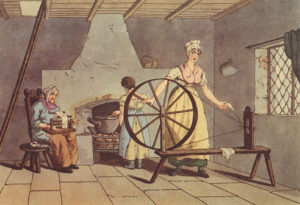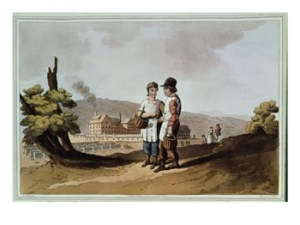Stephen Caunce promised us a different perspective on the Industrial Revolution and that’s exactly what we got. Stephen started by asking us to look at the area from Preston in the West to Wakefield in the East as one area with hills in the middle. Missed by glacial changes as seen in the Yorkshire or Derbyshire Dales the land is poor, traditionally used for raising cattle in the West and sheep in the East.

Domestic Spinner. Courtesy S Caumce
Sparsely populated and without a true feudal system, the people were independent, eking a living from the land and from spinning and weaving wool. However, they did have plentiful streams and rivers with a regular flow thanks to the huge peat covered uplands acting as reservoirs to power the water mills.
With the invention of the steam engine, the huge reserves of coal provided abundant fuel to allow industry to develop mass production on a scale never seen before.

Factory Children. Courtesy S. Caunce
Populations grew and towns and villages covered the landscape where life was actually better, with regular employment, food grown by local farms and delivered fresh by local farmers. Life in the very few cities may have been inhuman in small pockets of slums but for many it would have been possible to turn around and see open countryside.
The rapid development of the railways together with new seaside resorts like Blackpool brought a new concept to the masses – annual holidays or Wakes Weeks. A different viewpoint indeed.